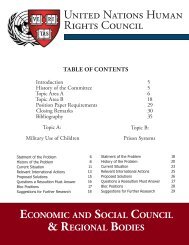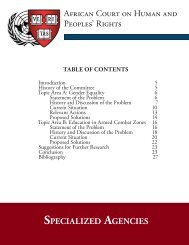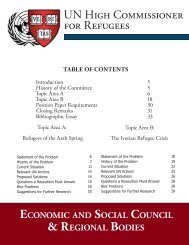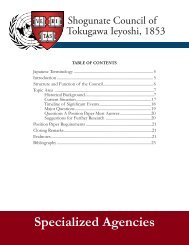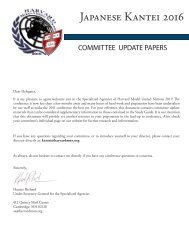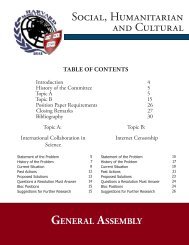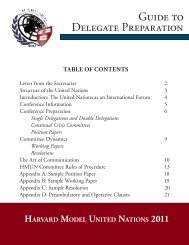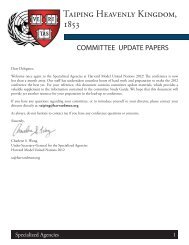World Trade Organization - Harvard Model United Nations
World Trade Organization - Harvard Model United Nations
World Trade Organization - Harvard Model United Nations
Create successful ePaper yourself
Turn your PDF publications into a flip-book with our unique Google optimized e-Paper software.
<strong>World</strong> <strong>Trade</strong> <strong>Organization</strong><br />
agreement (to limit trade in ozone-depleting substances)<br />
is not compromised. 73<br />
Environmental Goods<br />
One of the major challenges in the environmental<br />
goods debate is the lack of an internationally agreed<br />
definition of an environmental good. Working<br />
definitions do exist. Both the APEC and OECD define<br />
environmental goods as goods that “measure, prevent,<br />
limit, minimize or correct environmental damage to<br />
water, air and soil, as well as problems related to waste,<br />
noise and eco-systems... [including]<br />
cleaner technologies, products and<br />
services that reduce environmental<br />
risk and minimize pollution and<br />
resource use.” This is however a<br />
very broad development that can<br />
encompass goods of almost any<br />
sort. 74<br />
The lack of an internationally agreed definition<br />
leads to another problem. Negotiators have trouble<br />
addressing “problematic” environmental goods. These<br />
include environmental goods have multiple uses, some<br />
of which are not “environmental,” and goods that are<br />
defined by their superior environmental performance<br />
over comparable goods. These goods are problematic for<br />
several reasons. For example, the inclusion of some goods<br />
as environmental goods would create incentives to bribe<br />
customs officials to have certain goods be classified more<br />
favorably. The inclusion of other goods would require<br />
would require an international consensus on the criteria<br />
for creating new distinctions between products. 75<br />
Some examples of environmental goods with multiple<br />
end users include centrifuges. Separating harmful<br />
waste products from waste streams require centrifuges<br />
but centrifuges are also used in food processing and<br />
medicine. A report from the mid-1990s estimated that<br />
approximately only 10% of all centrifuges sold that<br />
year were for environmental purposes. So the question<br />
is: should centrifuges be an environmental good that<br />
receives preferential trade treatments? 76<br />
Thus, any international agreement regarding<br />
environmental goods must develop some procedures for<br />
ensuring that the product description and categorizing of<br />
goods are consistent and efficient.<br />
“One of the major challenges in the<br />
environmental goods debate is the<br />
lack of an internationally agreed<br />
definition of an environmental<br />
good...”<br />
Relevant Action<br />
Canada vs. European Communities: Asbestos<br />
In 1999, Canada challenged France’s ban on chrysotile<br />
asbestos as unnecessarily restrictive to trade because<br />
“controlled use” of the substance eliminated any harm to<br />
humans and the environment. The implications of this<br />
ruling were significant. Since asbestos is one of the most<br />
thoroughly studied toxic substances, a WTO’s ruling<br />
overturning France’s ban would’ve put into question<br />
which substances could indeed be banned. The WTO<br />
panel ruled in favor of France and<br />
the European communities based<br />
on Article XX of the GATT that<br />
stated that restrictive trade measures<br />
could be enacted when “necessary to<br />
protect animal, human, plant life or<br />
health.” 77<br />
Shrimp-turtle case<br />
In 1997, Indian, Malaysia, Pakistan, and Thailand<br />
challenged the US ban on the import of certain shrimps<br />
and shrimp products. The issue of turtles was at the core<br />
of the debate. The US Endangered Species Act requires<br />
that shrimp trawlers to use “turtle excluder devices”<br />
(TEDs) in their nets when fishing for shrimp. Another<br />
US law also bans the importation of shrimp and shrimp<br />
products that are not harvested using this technology. 78<br />
The WTO panel ruled against the US but for surprising<br />
reasons. It made clear that countries have the right to<br />
trade restrictions to protect the environment. However,<br />
the basis for the ruling was on non-discriminatory trade<br />
policies. While the US had the right to restrictions under<br />
Article XX, it did not apply its ban equally across all<br />
countries. Instead, it provided technical and financial<br />
assistance to countries in the Western hemisphere that<br />
helped the fishermen there acquire TEDs and avoid the<br />
ban. 79<br />
EU vs. US: Automobile Taxes<br />
In 1994, the European Union filed a complaint<br />
against three US automobile measures. They were the<br />
luxury tax on cars, the gas guzzler tax, and the Corporate<br />
Average Fuel Economy regulation (CAFE). The European<br />
Union believed that their cars were at a competitive<br />
disadvantage in the US market due to these legislations.<br />
The WTO panel found that the luxury and gas<br />
guzzler taxes were consistent with GATT articles while<br />
CAFE was ruled as inconsistent. The reason lied in the<br />
US having a separate foreign car accounting system<br />
20<br />
Specialized General Assembly Agencies





